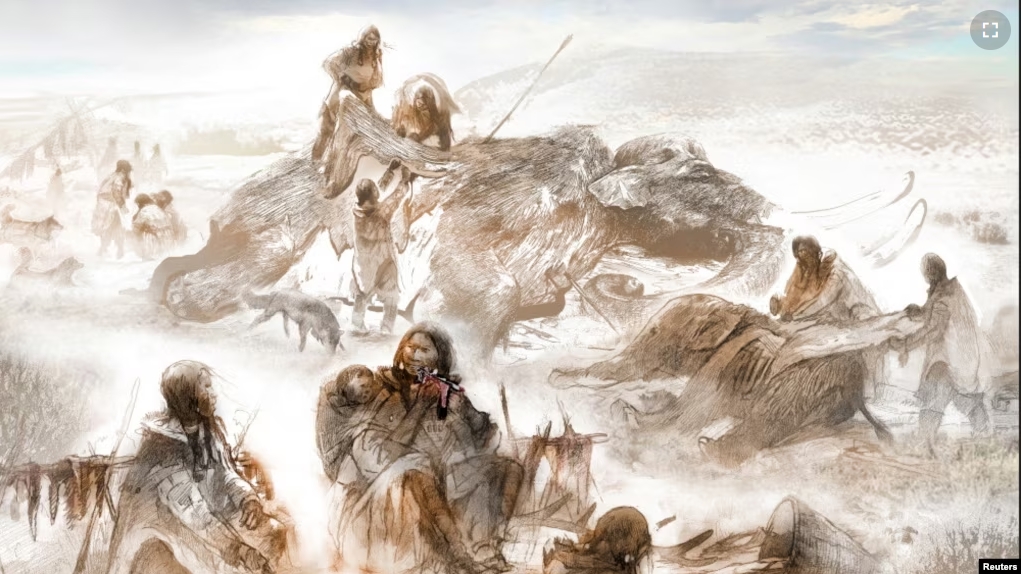A new study finds that the first humans to live in North America depended heavily on mammoths and other large animals for food.
The finding is based on examinations of the diet of a woman who lived about 13,000 years ago during the last Ice Age. She belonged to a culture called the Clovis. They were among the first Native Americans to arrive on the continent.
The woman was still breast-feeding her 18-month-old son when he died. The boy’s remains were discovered back in 1968 in an ancient burial ground in the western U.S. state of Montana. Scientists examined his bones to learn more about his mother’s diet.
They found that the woman ate mostly meat from mammoths and other very large animals. The finding supports scientific theories that Clovis people specialized in hunting large animals instead of seeking plants or small animals to eat.
At the time the Clovis people lived, large animals like mammoths lived in areas covering the Americas, as well as parts of northern Asia. The researchers noted that mammoths traveled very long distances during this period. This made them a target for migrating humans seeking protein-rich foods to eat.
The team examined isotope data collected from the boy’s bones to estimate the Clovis woman’s dietary intake. An isotope is a kind of atom that has a different atomic weight than similar atoms, but the same chemical structure. The isotope experiments centered on the elements carbon and nitrogen.
Mat Wooller is a professor and director of the Alaska Stable Isotope center at the University of Alaska Fairbanks. He was a co-writer of the study describing the research in the publication Science Advances.
Wooller told Reuters news agency isotope examinations can provide “a chemical fingerprint” of parts of an ancient human’s diet. “We are all made of elements, like carbon and nitrogen, and so is our food,” he said.
James Chatters is a professor of Earth, Environment and Society at Canada’s McMaster University. He helped lead the research. Chatters said in a statement that centering on mammoths “helps explain how Clovis people could spread throughout North America and into South America in just a few hundred years.”
The scientists estimated the woman mostly ate meat from a group of animals called megafauna, the largest creatures that existed at the time. The study showed megafauna made up about 96 percent of her diet, with mammoth accounting for about 40 percent of the total.
Chatters said one mammoth could support “a dependent community of children, care-giving women, and less mobile elders for days or even weeks while the hunters sought their next kill.” Mammoths stood to about four meters tall at the shoulder and weighed as much as 11 tons.
Chatters said the Clovis people were known to be highly skilled hunters with a 10,000-year history of hunting megafauna over wide areas of territory. He added that the great dependence of the Clovis on megafauna likely led to the pressures that later caused the extinction of large ice age animals.
Chatters noted the latest finding supports past studies that provided “indirect evidence” that Clovis people mainly depended on mammoths and other large animals for food. This evidence included examinations of different artifacts – such as stone tools or the ancient remains of large animals, he said.
Ben Potter was also a co-writer of the study. He is an archeologist at the University of Alaska Fairbanks. Potter told Reuters, “These results also help us understand megafauna extinctions at the end of the last Ice Age.” He added the findings suggest that humans may have played a more important part in the extinctions than is sometimes thought.
I’m Bryan Lynn.
Reuters reported this story. Bryan Lynn adapted the report for VOA Learning English, with additional information from the University of Alaska Fairbanks and Science Advances.
_____________________________________________
Words in This Story
mobile – adj. capable of moving or being moved
artifact – n. an object showing human work and representing a culture or a stage in the development of a culture
extinct – adj. no longer in existence
